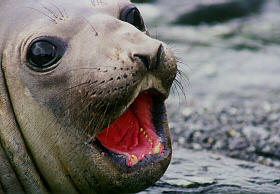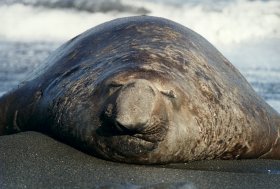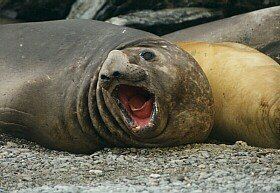Southern Elephant seal
Circumpolar, found on most subantarctic islands including South Georgia.
Largest of all seal species.
Male: Length: 6 meters
weight 3.5 Metric Tons
Female: Length: 3 meters weight 900 kg.
Male: Length: 6 meters
weight 3.5 Metric Tons
Female: Length: 3 meters weight 900 kg.
|
Female Elephant Seal, Curverville Island, Antarctic.This means: You are too close!!! |
Male Elephant Seal, Gold Harbour, South Georgia. This one we called "the Blob". |


| When first ashore, older male animals are golden-brown to light-brown. The newly moulted coat is dark grey. Females are generally darker brown. On younger animals the coat varies from light silvery-fawn to light grey-buff. At birth the pup is black. Breeding begins when adult males arrive on beaches in August, followed by the females a week later. Fighting than follows among the males to see who will be "beach master". Pups grow incredibly quickly, quadrupling their weight (the females milk is 50% fat) by the time they are weaned at 22 days of age. Their diet is predominantly squid, caught during very deep (below 1 km) and long dives. |
|
Southern Elephant Seal, Curverville Island, Antarctic.  |